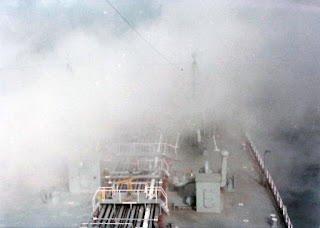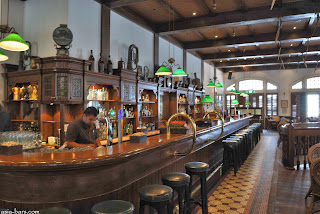Sea fog experienced just before snowstorm - northbound off Jacksonville, FL
 |
| On the bridge of the Callifornia - 1982 |
Shipping was slow during the early 80's. One of our mantras was "Stay alive 'til '85" when shipping was forecast to pick up (it didn't). We often steamed at economy speed because there were no orders for the next trip. Anchoring to await cargo was the norm. We would anchor off of Port Everglades or Sabine Pass or both. One of the longest voyages of my seagoing career was between the Delaware River and Port Arthur - around 30 days between ports - due to the time spent at anchor. The good thing about anchoring at Port Everglades was that the pilot boat always brought out the newspaper. One bright, moonlit night during the midnight to 0400 watch, I noticed a sailboat stopped nearby with a dinghy alongside. A man in the sailboat was passing items to a man in the dinghy. I thought it might be a drug transaction so I called Capt. Watts. Shortly thereafter, the sailboat made a mayday call on the VHF. Then the man in the sailboat climbed into the dinghy and began rowing away. Meanwhile, the now empty sailboat drifted right alongside the ship and started to sink. I turned on our spotlight and shone it down as we watched the sailboat disappear into the deep. We hailed the men in the dinghy but they had no desire to be helped. I think they were very surprised that we had witnessed the scuttling of their sailboat. The USCG came out shortly thereafter and took the men aboard. I was certain that there would be some kind of investigation but we never heard a word. I guess the insurance company just paid up.
 |
| Familiar Smokestacks at Port Everglades Power Plant (now gone) |
One night around 0300 while slow steaming toward Pascagoula, MS, I heard a faint distress call on the VHF. There was a sailboat with children on board sinking. Their position was near our course line about 2 hours away. I could see the lights of other ships in the area but no one else responded to the call. I had learned many years before from Capt. Healey on the Connecticut that you respond at all costs. In that instance, we responded to a distress call when we were 70 miles away and in the fog. When that boat was saved, we were only 1 mile from the site. This instance on the California was a no-brainer. I called Capt. Calhoun and we headed toward the scene, arriving at daybreak. We were in radio contact with the USCG who had sent a helicopter which also arrived at daybreak. The helicopter lowered a portable pump to the boat which was still afloat but riding low in the water. The portable pump would not start. With the USCG's permission, we lowered the port lifeboat and I motored over to the sailboat. There was a family of 4 on board. They had been up all night bailing water. We took them in tow, brought them alongside, lowered one of our portable pumps and pumped her out. A Coast Guard cutter arrived on scene just as we finished. They went on board and found a hole in the hull with a rag half stuck in it. Apparently, the owners had just bought the boat and wanted a fathometer installed. The boatyard drilled a hole too large for the transducer, stuffed a rag in it, then drilled a smaller hole. The first hole was never repaired and the boat sailed, an accident waiting to happen. The USCG took the boat in tow and headed back to Pascagoula. We docked the next day. There was a brief article in the paper about the rescue, with the Coast Guard taking all the credit. The Texaco California was not mentioned in the article.
Towing sinking sailboat alongside where we pumped her out and plugged the leak
C/E Jim Harley presenting Capt Watts with a retirement gift
C/E Jim Harley presenting Capt Watts with a retirement gift
During my time on the California, I exercised every day to build up strength in my lower back. It worked. I was able to start sailing Chief Mate again and had no problem physically handling the job. I was transferred to the Florida and sailed 2nd Mate and then Chief Mate there. Martino Pirone, Ed Lyons and Reggie Surette were the Captains during my time onboard. Capt. Pirone was a character. The voyages at the time were US Gulf to Chiriqui Grande, Panama. Our charter required us to maintain an overall speed of 15.5 knots for the voyage which was nearly impossible. I was directed to keep a second set of charts showing us taking a longer route to Panama than we actually sailed. One voyage, the charterers came aboard, checked the charts and didn't pick up on the discrepancy. Another of Capt. Pirone's idiosyncrasies were the notes he would leave for me on his door with instructions for the midnight watch. These notes usually had nothing to do with the voyage and were often brain teasers. At the least they were entertaining.
Chiriqui Grande was an interesting port. A pipeline had been built from the west coast Panamanian port of Puerto Armuelles across the isthmus to Chiriqui Grande to cut down the transit time of ships providing Alaskan Crude to Gulf Coast ports. On passing through the Bocas del Toro into Chiriqui Grande, the bay opened up providing more than ample space for tankers to load from a submarine pipeline. The village there appeared small, not much more than a fishing village. Local fisherman in wooden skiffs used to sell large langousta to the ships for $2 a piece. Inflation caught on fast. A few trips later, the fishermen had aluminum skiffs with fancy outboard motors and the price of langousta had doubled. It was still worth the inflated price. There was a running competition between the Chief Mates Jack Briggs and Jay Kelly to see who could load the ship the fastest. 6 1/2 hours was an average loading time. A new record was set almost every voyage.
The Florida was due for shipyarding. Texaco had recently started using foreign shipyards to cut down on repair costs. The Florida was sent to the Hitachi Zozen shipyard in Jurong, Singapore. I was on leave during the trip over and was scheduled to rejoin in Singapore. I decided to seize the opportunity and leave a few days early so I could visit Hong Kong on the way. I pre-booked a room for 2 nights in the New World Hotel in Kowloon. On the flight over, I had to change planes in San Francisco. Who do I run into there but Manny Altmann, the Port Engineer who was handling our shipyarding. He was going over early to meet with shipyard personnel before the ship arrived. Manny told me the ship had been delayed by several days, gave me his hotel information in Singapore and told me to call him when I arrived. I was unable to sleep on the flight to Hong Kong and checked in to the hotel exhausted. I slept from noon til 8 the next morning. I signed up for a full-day bus tour of Hong Kong. The tour highlights included a stop at the Tiger Balm Gardens, a sampan ride through the fishing village of Aberdeen and a tram trip to the top of Victoria Peak. I was disappointed to see the huge change in the number of fishing boats in Aberdeen. In what was surely called progress, many boat people were forcefully relocated to ugly apartment buildings on shore. The second day in Hong Kong I took a bus tour to Lok-Ma-Chau in the New Territories.
 |
| View from Lok Ma Chau |
The driver must have been 90 years old and was fearless, bicycling in and out of traffic comfortably. The tour wound up at the Raffles Hotel where I partook of the famous Singapore Sling libation at the Long Bar. The Singapore Sling turned out to be not much more than a ladies drink. The Tiger Beer was better.

Harking back to my cadet days in the Far East, where pirated records were sold everywhere, pirated cassette tapes were now the hot item. I loaded up on them. My wife had given me a list as well so I spent the few days before the ship arrived shopping.
The ship finally arrived offshore. Manny and I took a 4 hour launch ride to join. Some final tank cleaning was in progress and I went right to work mucking tanks. We spent 2 days finishing up the tank cleaning operations before proceeding to Jurong Hitachi Zozen shipyard. It was already hot and the work onboard only made it worse. I sweated through my work clothes continuously and took 5 showers day, in the morning, at morning coffee time, at lunch, at afternoon coffee time and before supper, to try to stay cool. The shipyard was a 30 minute cab ride from downtown Singapore so I was glad to have done my most of my sightseeing ahead of time. If you wanted to take public transportation, you could but it meant changing buses at the Jurong terminal and took close to an hour what with all the stops. The few times I went into town, I hitched a ride with the USCG inspector.
 |
| Jurong Bus Interchange |
The first loaded trip out of Valdez was an eye-opener. We encountered a horrific storm in the Gulf of Alaska and repeatedly took green water over the bow. I was called at 2200 that night to go up on the bow with the Chief Engineer and Bosun to secure the hatch cover to the forward rope locker which had broken loose and was sliding around the focsle head. The captain changed course to put the seas on the quarter and the three of us went forward and secured the hatch cover. Even with the course change, seas were still breaking on deck and we had to be really careful to avoid being washed overboard. Back on course again and with an open hatch on the focsle, the captain slowed the ship down to avoid taking further water over the bow. The next morning, the storm subsided as quickly as it had occurred and the rest of the voyage was uneventful.
Our discharge port was Tacoma. Reggie Surrette rejoined as Master. He misunderstood the voluminous ballast instructions for Prince William Sound and told me to only take ballast in the dedicated ballast tanks. This was barely enough ballast to maneuver in inland waters and certainly not enough to transit the Gulf of Alaska. I told him about the storm we had encountered on the trip down and he finally agreed to let me take full ballast. I made one more trip on the Florida then went on vacation. I rejoined the Florida in August and made another round trip from Tacoma to Valdez before being transferred to the Texaco Minnesota which was to become my home for the next 3 1/2 years.









